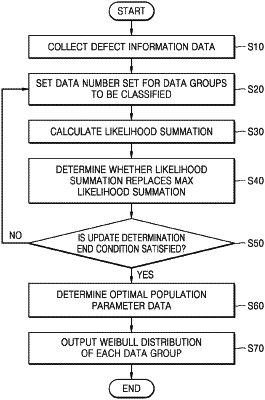| CPC G06F 17/18 (2013.01) [G06F 17/15 (2013.01); H01L 22/12 (2013.01); H01L 22/20 (2013.01)] | 20 Claims |

|
1. A method for identifying defects on a plurality of semiconductor devices, the method comprising:
performing, using at least one of one or more external computing devices, a quality evaluation process by selectively applying at least one of a test voltage or a test current to each of a plurality of wafers;
generating, using the at least one of the one or more external computing devices, defect information data of defect characteristics identified in the plurality of wafers on which the quality evaluation process is performed;
establishing, using a communication interface of a distribution output device, data communication with the at least one of the one or more external computing devices;
receiving, using the communication interface and from the at least one of the one or more external computing devices, the defect information data of defect characteristics identified in the plurality of wafers, the defect information data including defect times associated with the defect characteristics;
setting, using at least one processor of the distribution output device, a data number set for a plurality of data groups to be classified in an order of occurrence for the defect times, the plurality of data groups corresponding to different defect characteristics among the defect characteristics and the data number set comprising a specified number of defect times for each of the plurality of data groups;
designating, using the at least one processor, the defect times across the plurality of data groups based on the data number set;
determining, using the at least one processor, whether a likelihood summation based on likelihoods respectively corresponding to the plurality of data groups replaces a maximum likelihood summation;
determining, using the at least one processor, optimal population parameter data for each of the plurality of data groups in relation to the maximum likelihood summation;
transmitting, using the communication interface and to at least one of the one or more external computing devices, a Weibull distribution for each of the plurality of data groups corresponding to the different defect characteristics in relation to the optimal population parameter data for each of the plurality of data groups; and
controlling at least one of the one or more external computing devices to, based on the Weibull distribution, generate a comparative visualization of probability distributions of defect times for the defect characteristics identified in the plurality of wafers for each of the plurality of data groups corresponding to the different defect characteristics.
|